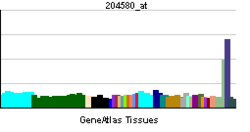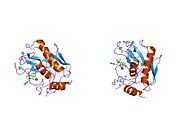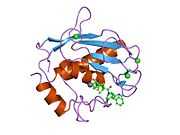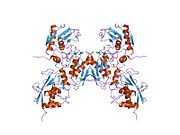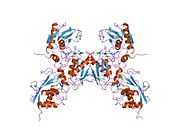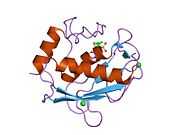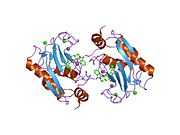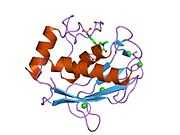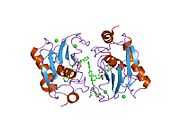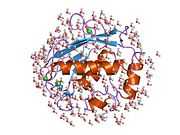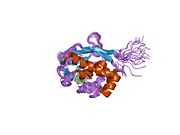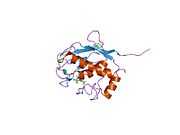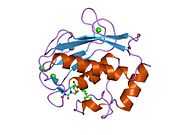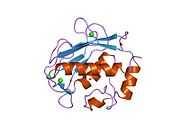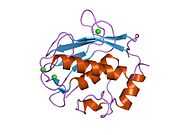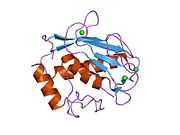Matrix metallopeptidase 12
| Matrix metallopeptidase 12 (macrophage elastase) |
|---|
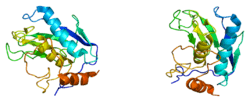
PDB rendering based on 1jiz. |
| Available structures |
| PDB |
Ortholog search: PDBe, RCSB |
| List of PDB id codes |
|
1JIZ, 1JK3, 1OS2, 1OS9, 1RMZ, 1ROS, 1UTT, 1UTZ, 1Y93, 1YCM, 1Z3J, 2HU6, 2JXY, 2K2G, 2K9C, 2KRJ, 2OXU, 2OXW, 2OXZ, 2POJ, 2W0D, 2WO8, 2WO9, 2WOA, 2Z2D, 3BA0, 3EHX, 3EHY, 3F15, 3F16, 3F17, 3F18, 3F19, 3F1A, 3LIK, 3LIL, 3LIR, 3LJG, 3LK8, 3LKA, 3N2U, 3N2V, 3NX7, 3RTS, 3RTT, 3TS4, 3TSK, 3UVC, 4EFS, 4GQL, 4GR0, 4GR3, 4GR8, 4GUY, 4H30, 4H49, 4H76, 4H84, 4I03, 4IJO
|
|
|
| Identifiers |
|---|
| Symbols | MMP12 ; HME; ME; MME; MMP-12 |
|---|
| External IDs | OMIM: 601046 MGI: 97005 HomoloGene: 20547 IUPHAR: 1636 ChEMBL: 4393 GeneCards: MMP12 Gene |
|---|
| EC number | 3.4.24.65 |
|---|
|
| RNA expression pattern |
|---|
|
| More reference expression data |
| Orthologs |
|---|
| Species | Human | Mouse | |
|---|
| Entrez | 4321 | 17381 | |
|---|
| Ensembl | ENSG00000110347 | ENSMUSG00000049723 | |
|---|
| UniProt | P39900 | P34960 | |
|---|
| RefSeq (mRNA) | NM_002426 | NM_008605 | |
|---|
| RefSeq (protein) | NP_002417 | NP_032631 | |
|---|
| Location (UCSC) | Chr 11:
102.73 – 102.75 Mb | Chr 9:
7.34 – 7.37 Mb | |
|---|
| PubMed search | | | |
|---|
|
Matrix metalloproteinase-12 (MMP-12) also known as macrophage metalloelastase (MME) or macrophage elastase (ME) is an enzyme that in humans is encoded by the MMP12 gene.[1][2][3]
Function
Proteins of the matrix metalloproteinase (MMP) family are involved in the breakdown of extracellular matrix in normal physiological processes, such as embryonic development, reproduction, and tissue remodeling, as well as in disease processes, such as arthritis and metastasis. Most MMP's are secreted as inactive proproteins. The prodomain is cleaved by extracellular proteinases when the enzyme is activated. The active enzyme is constituted by two domains, the catalytic domain resposnsible for its enzymatic activity and the hemopexin-like domain that in some MMPs plays a role in substrate recognition and can contribute to increasing catalytic efficiency. It is thought that the protein encoded by this gene is cleaved at both ends to yield the active enzyme, but this processing has not been fully described. The enzyme degrades soluble and insoluble elastin. The gene is part of a cluster of MMP genes which localize to chromosome 11q22.3.[1]
Clinical significance
MMP12 may play a role in aneurysm formation[4] and studies in mice and humans suggest a role in the development of emphysema.[5]
References
- ↑ 1.0 1.1 "Entrez Gene: MMP12 matrix metallopeptidase 12 (macrophage elastase)".
- ↑ Shapiro SD, Kobayashi DK, Ley TJ (November 1993). "Cloning and characterization of a unique elastolytic metalloproteinase produced by human alveolar macrophages". J. Biol. Chem. 268 (32): 23824–9. PMID 8226919.
- ↑ Belaaouaj A, Shipley JM, Kobayashi DK, Zimonjic DB, Popescu N, Silverman GA, Shapiro SD (June 1995). "Human macrophage metalloelastase. Genomic organization, chromosomal location, gene linkage, and tissue-specific expression". J. Biol. Chem. 270 (24): 14568–75. doi:10.1074/jbc.270.24.14568. PMID 7782320.
- ↑ Curci JA, Liao S, Huffman MD, Shapiro SD, Thompson RW (December 1998). "Expression and localization of macrophage elastase (matrix metalloproteinase-12) in abdominal aortic aneurysms". J. Clin. Invest. 102 (11): 1900–10. doi:10.1172/JCI2182. PMC 509141. PMID 9835614.
- ↑ Woodruff PG, Koth LL, Yang YH, Rodriguez MW, Favoreto S, Dolganov GM, Paquet AC, Erle DJ (December 2005). "A Distinctive Alveolar Macrophage Activation State Induced by Cigarette Smoking". Am. J. Respir. Crit. Care Med. 172 (11): 1383–92. doi:10.1164/rccm.200505-686OC. PMC 2718436. PMID 16166618.
Further reading
- Nagase H, Woessner JF (1999). "Matrix metalloproteinases". J. Biol. Chem. 274 (31): 21491–4. doi:10.1074/jbc.274.31.21491. PMID 10419448.
- Pendás AM, Santamaría I, Alvarez MV et al. (1997). "Fine physical mapping of the human matrix metalloproteinase genes clustered on chromosome 11q22.3". Genomics 37 (2): 266–8. doi:10.1006/geno.1996.0557. PMID 8921407.
- Gronski TJ, Martin RL, Kobayashi DK et al. (1997). "Hydrolysis of a broad spectrum of extracellular matrix proteins by human macrophage elastase". J. Biol. Chem. 272 (18): 12189–94. doi:10.1074/jbc.272.18.12189. PMID 9115292.
- Edelstein C, Shapiro SD, Klezovitch O, Scanu AM (1999). "Macrophage metalloelastase, MMP-12, cleaves human apolipoprotein(a) in the linker region between kringles IV-4 and IV-5. Potential relevance to lipoprotein(a) biology". J. Biol. Chem. 274 (15): 10019–23. doi:10.1074/jbc.274.15.10019. PMID 10187779.
- Dias Neto E, Correa RG, Verjovski-Almeida S et al. (2000). "Shotgun sequencing of the human transcriptome with ORF expressed sequence tags". Proc. Natl. Acad. Sci. U.S.A. 97 (7): 3491–6. doi:10.1073/pnas.97.7.3491. PMC 16267. PMID 10737800.
- Wert SE, Yoshida M, LeVine AM et al. (2000). "Increased metalloproteinase activity, oxidant production, and emphysema in surfactant protein D gene-inactivated mice". Proc. Natl. Acad. Sci. U.S.A. 97 (11): 5972–7. doi:10.1073/pnas.100448997. PMC 18543. PMID 10801980.
- Belaaouaj AA, Li A, Wun TC et al. (2000). "Matrix metalloproteinases cleave tissue factor pathway inhibitor. Effects on coagulation". J. Biol. Chem. 275 (35): 27123–8. doi:10.1074/jbc.M004218200. PMID 10859319.
- Hiller O, Lichte A, Oberpichler A et al. (2000). "Matrix metalloproteinases collagenase-2, macrophage elastase, collagenase-3, and membrane type 1-matrix metalloproteinase impair clotting by degradation of fibrinogen and factor XII". J. Biol. Chem. 275 (42): 33008–13. doi:10.1074/jbc.M001836200. PMID 10930399.
- Terp GE, Christensen IT, Jørgensen FS (2000). "Structural differences of matrix metalloproteinases. Homology modeling and energy minimization of enzyme-substrate complexes". J. Biomol. Struct. Dyn. 17 (6): 933–46. doi:10.1080/07391102.2000.10506582. PMID 10949161.
- Agapova OA, Ricard CS, Salvador-Silva M, Hernandez MR (2001). "Expression of matrix metalloproteinases and tissue inhibitors of metalloproteinases in human optic nerve head astrocytes". Glia 33 (3): 205–16. doi:10.1002/1098-1136(200103)33:3<205::AID-GLIA1019>3.0.CO;2-D. PMID 11241738.
- Lang R, Kocourek A, Braun M et al. (2001). "Substrate specificity determinants of human macrophage elastase (MMP-12) based on the 1.1 A crystal structure". J. Mol. Biol. 312 (4): 731–42. doi:10.1006/jmbi.2001.4954. PMID 11575928.
- Nar H, Werle K, Bauer MM et al. (2001). "Crystal structure of human macrophage elastase (MMP-12) in complex with a hydroxamic acid inhibitor". J. Mol. Biol. 312 (4): 743–51. doi:10.1006/jmbi.2001.4953. PMID 11575929.
- Joos L, He JQ, Shepherdson MB et al. (2002). "The role of matrix metalloproteinase polymorphisms in the rate of decline in lung function". Hum. Mol. Genet. 11 (5): 569–76. doi:10.1093/hmg/11.5.569. PMID 11875051.
- Andolfo A, English WR, Resnati M et al. (2003). "Metalloproteases cleave the urokinase-type plasminogen activator receptor in the D1-D2 linker region and expose epitopes not present in the intact soluble receptor". Thromb. Haemost. 88 (2): 298–306. PMID 12195704.
- Strausberg RL, Feingold EA, Grouse LH et al. (2003). "Generation and initial analysis of more than 15,000 full-length human and mouse cDNA sequences". Proc. Natl. Acad. Sci. U.S.A. 99 (26): 16899–903. doi:10.1073/pnas.242603899. PMC 139241. PMID 12477932.
- Vos CM, van Haastert ES, de Groot CJ et al. (2003). "Matrix metalloproteinase-12 is expressed in phagocytotic macrophages in active multiple sclerosis lesions". J. Neuroimmunol. 138 (1–2): 106–14. doi:10.1016/S0165-5728(03)00036-5. PMID 12742660.
- Anghelina M, Schmeisser A, Krishnan P et al. (2003). "Migration of monocytes/macrophages in vitro and in vivo is accompanied by MMP12-dependent tunnel formation and by neovascularization". Cold Spring Harb. Symp. Quant. Biol. 67: 209–15. doi:10.1101/sqb.2002.67.209. PMID 12858542.
External links
- The MEROPS online database for peptidases and their inhibitors: M10.009
PDB gallery |
|---|
| | 1jiz: Crystal Structure Analysis of human Macrophage Elastase MMP-12 |
| 1jk3: Crystal structure of human MMP-12 (Macrophage Elastase) at true atomic resolution |
| 1os2: Ternary enzyme-product-inhibitor complexes of human MMP12 |
| 1os9: Binary enzyme-product complexes of human MMP12 |
| 1rmz: Crystal structure of the catalytic domain of human MMP12 complexed with the inhibitor NNGH at 1.3 A resolution |
| 1ros: Crystal structure of MMP-12 complexed to 2-(1,3-dioxo-1,3-dihydro-2H-isoindol-2-yl)ethyl-4-(4-ethoxy[1,1-biphenyl]-4-yl)-4-oxobutanoic acid |
| 1utt: CRYSTAL STRUCTURE OF MMP-12 COMPLEXED TO 2-(1,3-DIOXO-1,3-DIHYDRO-2H-ISOINDOL-2-YL)ETHYL-4-(4-ETHOXY[1,1-BIPHENYL]-4-YL)-4-OXOBUTANOIC ACID |
| 1utz: CRYSTAL STRUCTURE OF MMP-12 COMPLEXED TO (2R)-3-({[4-[(PYRI DIN-4-YL)PHENYL]-THIEN-2-YL}CARBOXAMIDO)(PHENYL)PROPANOIC ACID |
| 1y93: Crystal structure of the catalytic domain of human MMP12 complexed with acetohydroxamic acid at atomic resolution |
| 1ycm: Solution Structure of matrix metalloproteinase 12 (MMP12) in the presence of N-Isobutyl-N-[4-methoxyphenylsulfonyl]glycyl hydroxamic acid (NNGH) |
| 1z3j: Solution Structure of MMP12 in the presence of N-isobutyl-N-4-methoxyphenylsulfonyl]glycyl hydroxamic acid (NNGH) |
| 2hu6: Crystal structure of human MMP-12 in complex with acetohydroxamic acid and a bicyclic inhibitor |
| 2oxu: Uninhibited form of human MMP-12 |
| 2oxw: Human MMP-12 complexed with the peptide IAG |
| 2oxz: Human MMP-12 in complex with two peptides PQG and IAG |
|
|
|

